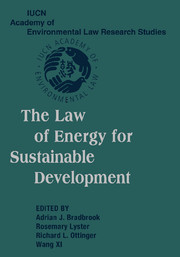Book contents
- Frontmatter
- Contents
- Acknowledgments
- Message from Kofi A. Annan, Secretary-General, United Nations
- Introduction – A Global Learned Society to Address Earth's Evolution: The IUCN Academy of Environmental Law
- Public Lectures on International Environmental Law
- PART ONE SUSTAINABLE DEVELOPMENT AND THE ROLE OF ENERGY LAW
- PART TWO LEGAL ISSUES IN CONTEMPORARY ENERGY LAW
- PART THREE INTERNATIONAL ENERGY LAW
- PART FOUR COMPARATIVE ENERGY LAW
- PART FIVE ELECTRICITY RESTRUCTURING
- 24 Some Environmental Lessons from Electricity Restructuring
- 25 The Implications of Electricity Restructuring for a Sustainable Energy Framework: What's Law Got to Do with It?
- 26 Electricity Market Liberalization and Energy Sustainability
- PART SIX FINANCING FOR SUSTAINABLE ENERGY
- PART SEVEN CIVIL SOCIETY AND THE PROCEDURAL REQUIREMENTS OF ENERGY LAW FOR SUSTAINABLE DEVELOPMENT
- Index
24 - Some Environmental Lessons from Electricity Restructuring
Published online by Cambridge University Press: 10 August 2009
- Frontmatter
- Contents
- Acknowledgments
- Message from Kofi A. Annan, Secretary-General, United Nations
- Introduction – A Global Learned Society to Address Earth's Evolution: The IUCN Academy of Environmental Law
- Public Lectures on International Environmental Law
- PART ONE SUSTAINABLE DEVELOPMENT AND THE ROLE OF ENERGY LAW
- PART TWO LEGAL ISSUES IN CONTEMPORARY ENERGY LAW
- PART THREE INTERNATIONAL ENERGY LAW
- PART FOUR COMPARATIVE ENERGY LAW
- PART FIVE ELECTRICITY RESTRUCTURING
- 24 Some Environmental Lessons from Electricity Restructuring
- 25 The Implications of Electricity Restructuring for a Sustainable Energy Framework: What's Law Got to Do with It?
- 26 Electricity Market Liberalization and Energy Sustainability
- PART SIX FINANCING FOR SUSTAINABLE ENERGY
- PART SEVEN CIVIL SOCIETY AND THE PROCEDURAL REQUIREMENTS OF ENERGY LAW FOR SUSTAINABLE DEVELOPMENT
- Index
Summary
INTRODUCTION
Electricity restructuring is often analyzed in economic, legal, or technical terms. Its environmental implications are either not considered or are treated as secondary concerns. The electricity industry's worldwide share of significant air pollutants is substantial, so any change in the industry's methods of operation will have environmental significance, even if unintended. Furthermore, in some countries reliance on nuclear power, or on the construction of large hydroelectric facilities, has significant impacts other than air emissions. The purpose of this chapter is to explore several lessons from recent experience with electricity restructuring in a way that gives a higher priority to these substantial environmental dimensions.
DEFINING ELECTRICITY RESTRUCTURING
It is important at the outset to establish what is meant by “electricity restructuring.” The term has several different meanings, and considerable confusion can arise when a speaker has something different in mind than do the listeners. As used in the United States and other developed countries, electricity restructuring is likely to include at least some of the following concepts:
the separation of formerly vertically integrated utilities into individual components of generation, transmission, and distribution;
open access by all sellers of power over the monopoly transmission wires to the purchaser(s) of the power;
an “independent” regulatory institution to set tariffs and issue licenses, normally with a goal of establishing tariffs that cover the full costs of producing and delivering electricity;
competition among several different sellers of electricity generation;
private ownership in the generation sector and perhaps transmission and distribution as well; and
possible customer choice among different suppliers of electricity.
- Type
- Chapter
- Information
- The Law of Energy for Sustainable Development , pp. 407 - 414Publisher: Cambridge University PressPrint publication year: 2005



